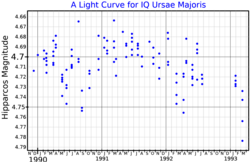| Observation data Epoch J2000 Equinox J2000 | |
|---|---|
| Constellation | Ursa Major |
| Right ascension | 13h 40m 44.27274s [2] |
| Declination | +54° 40′ 53.8860″ [2] |
| Apparent magnitude (V) | 4.69 - 4.75 [3] |
| Characteristics | |
| Spectral type | M2 III [4] |
| B−V color index | +1.630±0.006 [5] |
| Variable type | SRb [3] |
| Astrometry | |
| Radial velocity (Rv) | −18.61±0.20 [6] km/s |
| Proper motion (μ) | RA: −19.418 mas/yr [2] Dec.: −10.63 mas/yr [2] |
| Parallax (π) | 5.5963±0.1399 mas [2] |
| Distance | 580 ± 10 ly (179 ± 4 pc) |
| Absolute magnitude (MV) | −1.39 [5] |
| Details | |
| Mass | 1.1 [7] M☉ |
| Radius | 83.3±3.1 [8] R☉ |
| Luminosity | 1,250 [9] L☉ |
| Surface gravity (log g) | 1.06±0.16 [10] cgs |
| Temperature | 3,705±16 [10] K |
| Metallicity [Fe/H] | −0.1±0.08 [10] dex |
| Other designations | |
| 83 UMa, IQ UMa, BD+55°1625, HD 119228, HIP 66738, HR 5154, SAO 28843 [11] | |
| Database references | |
| SIMBAD | data |
83 Ursae Majoris is a candidate binary star [12] system in the northern circumpolar constellation of Ursa Major. It is a semiregular variable star, and it has been given the variable star designation IQ Ursae Majoris. It ranges in brightness from apparent visual magnitude 4.69 to 4.75, making it visible to the naked eye under good observing conditions. [3] Percy and Au (1994) identified it as a small amplitude red variable with an irregular behavior, having a characteristic time scale of 20 days. [13] Based upon an annual parallax shift of 5.60 mas , [2] it is located roughly 580 light years from the Sun. The system is moving closer with a heliocentric radial velocity of −18.6 [6] km/s.
The visible component is an evolved red giant with a stellar classification of M2 III. [4] It is a marginal barium star, showing an enhanced abundance of s-process elements in its outer atmosphere. This material may have been acquired during a previous mass transfer from a now white dwarf companion, or self-enriched by a dredge-up during the asymptotic giant branch process. [14]
